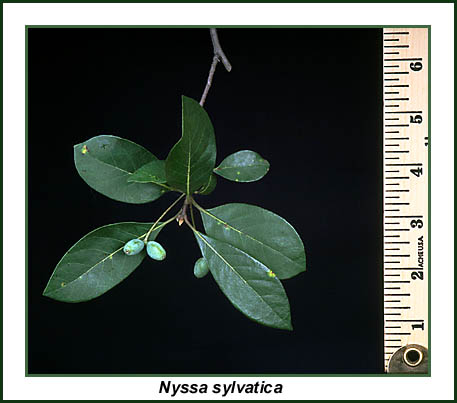Swamp Tupelo
Nyssa sylvatica var. biflora
Family: Cornaceae
Natural History

Nyssa sylvatica is a member of the dogwood family. One of its common names, swamp tupelo, is derived from the Native American Creek "ito opilwa," meaning swamp tree. Swamp tupelo is best adapted to wet, acid bottomlands, where its lower trunk is buttressed or swollen. It can also grow on drier sites with rich acid soils. Its glossy green leaves and beautiful fall foliage make it a popular landscaping tree.
The Nyssa family is also highly sought after by bee keepers because of the special tasting and non-crystallizing honey they help produce. In the past, hollowed swamp tupelo trunks, also called black gum, were used as bee hives and rabbit traps, called bee-gums and rabbit-gums.
The bluish black fruit ripen in September and October. Swamp tupelo is an important species for the wildlife of North America. Wood ducks, wild turkeys, robins, foxes, and black bears depend on the dark blue fruit as a source of food in the fall. White-tailed deer and beavers savor the flavor of the leaves and twigs.
Black gum is a tough wood suitable for tool handles, flooring and railroad cross-ties. Larger trees make an excellent veneer that is easily stained and the smaller trees are frequently used to make paper. Twigs broken off at right angles produce a fibrous bundle of woody tissue that was used as a tooth brush; hence one of black gum's common names is pioneer's toothbrush.
Black gum ranges from Texas to Oklahoma, Arkansas, Louisiana; east to Florida, north to Maine, and west to Michigan and Wisconsin. Trees range in height from 50 to 130 feet, averaging 80 feet. A "champion" black gum in Arkansas has a circumference of 17 feet, is 144 feet tall, and has a crown spread of 95 feet. In areas frequented by fire, black gum may be mostly shrubby sprouts.
One of the keys to identifying this species is to look at the pith, or center of the twig. It has a chambered appearance unlike the pith of similar species, such as the common persimmon (Diospyros virginiana) tree where the pith is constantly solid.
